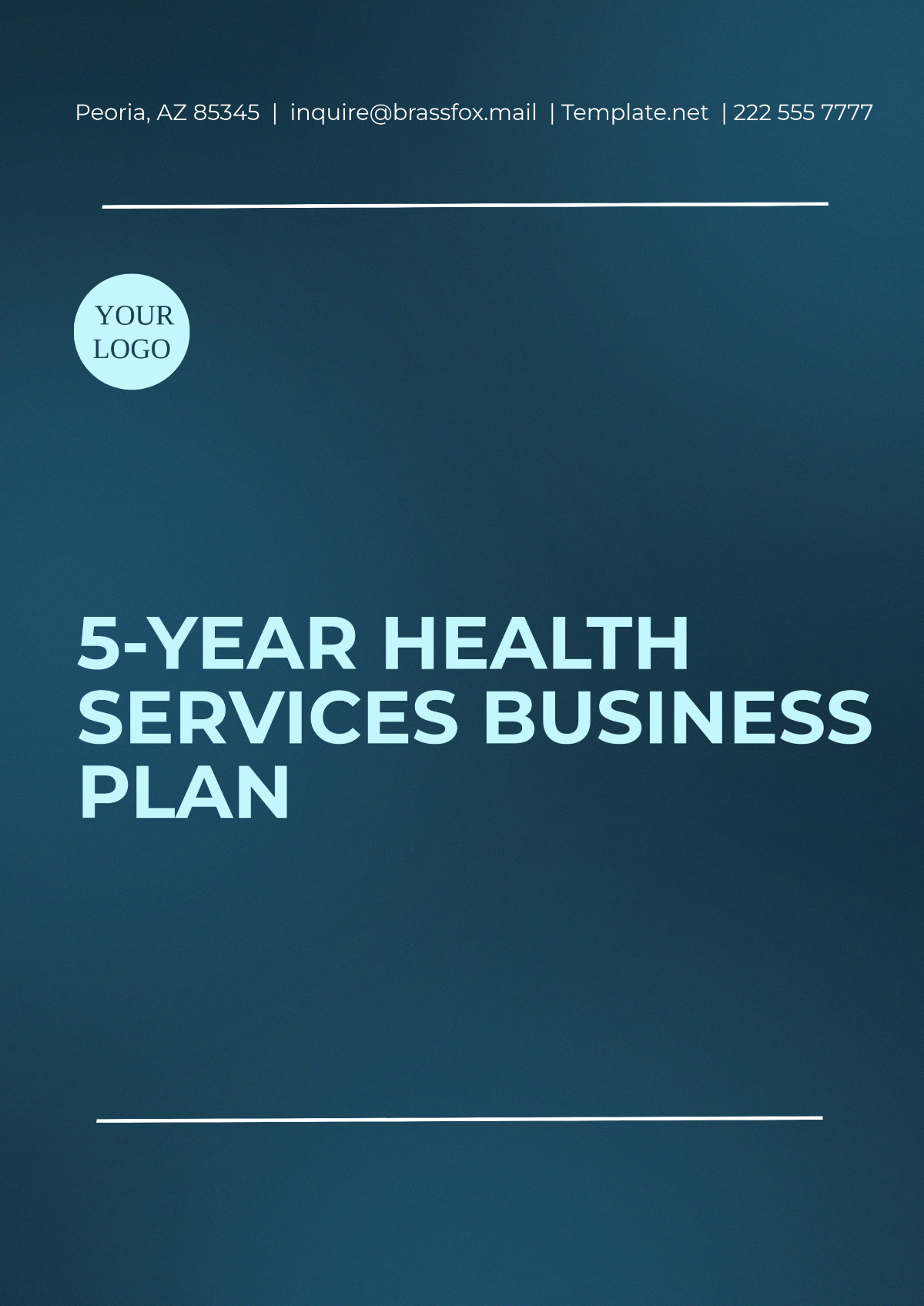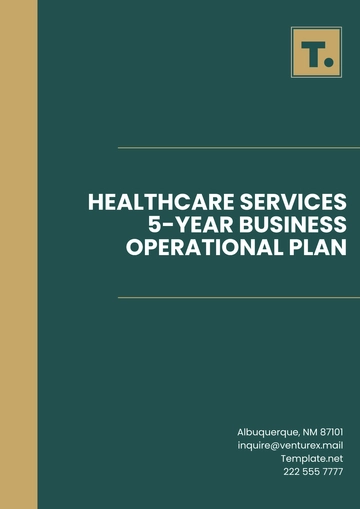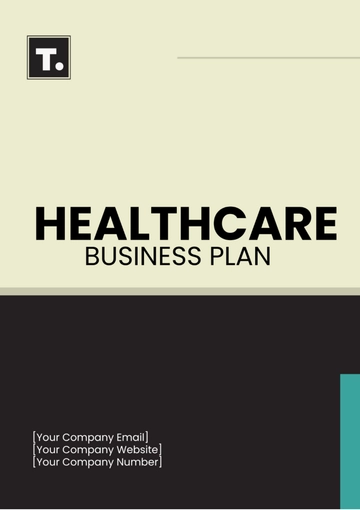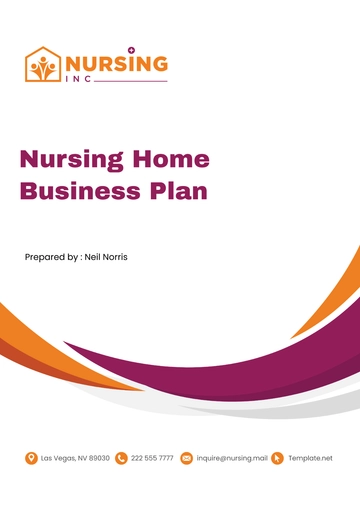Free 5-Year Health Services Business Plan

1. Executive Summary
This Health Services Business Plan outlines the strategic direction, goals, and key actions for [Your Company Name] to enhance healthcare delivery, improve patient outcomes, and expand service offerings. Our approach aims to address current healthcare challenges, embrace technological advancements, and provide innovative solutions for a sustainable future.
Organization Overview:
[Your Company Name] is a leading healthcare provider committed to delivering high-quality medical care across urban and rural regions in North America. With a strong focus on patient-centered care, our organization offers services such as emergency care, chronic disease management, primary care, and specialized treatments. We aim to enhance accessibility, affordability, and efficiency in healthcare delivery.
Strategic Objectives for 2060-2065:
Expand patient care services by 30% over the next five years.
Implement electronic health records (EHR) integration by 2062 to improve operational efficiency.
Develop partnerships with telemedicine platforms for remote patient care in rural areas by 2064.
Open two new healthcare centers in underserved regions by 2064.
2. Mission and Vision Statements
Mission Statement:
"To provide accessible, affordable, and high-quality healthcare services that empower individuals to live healthier lives through patient-centered care, innovative treatments, and sustainable practices."
Vision Statement:
"To be a leading healthcare provider, recognized for excellence in patient care, innovation in service delivery, and dedication to the health and wellbeing of our community."
3. SWOT Analysis
Strengths:
Well-established reputation for quality care in both urban and rural communities.
Skilled medical staff with expertise across a wide range of specialties, including cardiology, oncology, and pediatrics.
Strong partnerships with pharmaceutical and medical technology companies for research and development.
Weaknesses:
Limited investment in digital health technologies and infrastructure in rural centers.
High patient volume leads to occasional delays in non-emergency care.
Some aging infrastructure requires significant investment in modernization.
Opportunities:
Expansion into telemedicine services to provide remote consultations, particularly in rural areas.
Increasing government healthcare funding for innovation in rural healthcare delivery.
Collaborative research and treatment programs with universities and pharmaceutical companies.
Threats:
Increasing competition from private healthcare providers and international healthcare chains.
Regulatory changes impacting healthcare reimbursement rates and payment structures.
Rising healthcare costs and the potential for reduced patient affordability in certain demographics.
4. Goals and Objectives
Goal 1: Improve patient access to care by expanding telemedicine services by 50% by 2063.
Objective: Launch a user-friendly telemedicine platform by Q3 2061, offering virtual consultations for patients.
Objective: Increase telemedicine consultations from 5% of all appointments in 2060 to 20% by 2065.
Goal 2: Enhance operational efficiency through the adoption of electronic health records (EHR) and automation systems by 2062.
Objective: Complete the integration of EHR in all healthcare centers by mid-2062.
Objective: Achieve a 25% reduction in administrative time spent on patient data entry by 2065.
Goal 3: Expand services in underserved areas by opening two new healthcare centers in rural regions by 2064.
Objective: Complete site selection and community outreach programs by Q4 2061.
Objective: Launch operations at the first rural center by Q2 2063.
5. Key Strategies and Initiatives
Strategy 1: Develop Telemedicine Partnerships
Initiative: Partner with [Telemedicine Platform Name] to provide remote healthcare services across rural communities by 2062.
Initiative: Invest in marketing campaigns to educate patients about the benefits of telemedicine for non-urgent care and consultation.
Initiative: Offer telemedicine consultations for common medical conditions such as cold and flu, mental health counseling, and follow-up care for chronic diseases.
Strategy 2: Infrastructure Modernization
Initiative: Secure a $10 million investment for facility upgrades and modern equipment by the end of 2061.
Initiative: Build a new central medical facility equipped with cutting-edge technology by 2065, including diagnostic imaging, robotic surgery, and AI-assisted diagnosis tools.
Strategy 3: Workforce Development
Initiative: Launch a training program for current staff to learn new digital health tools and technologies by 2062.
Initiative: Create partnerships with local universities such as [University Name] to offer scholarships, internships, and job placement for future healthcare professionals, especially nurses and medical technologists.
6. Resource Allocation and Budget
A. Total Budget for 2060-2065: $50 million
Telemedicine Expansion: $15 million (2060-2063)
Infrastructure Modernization: $20 million (2061-2065)
Workforce Training and Development: $5 million (2060-2065)
Marketing and Patient Outreach: $5 million (2060-2065)
Contingency Fund: $5 million
B. Resource Allocation Breakdown:
Personnel Costs (50%): $25 million
Technology Investments (25%): $12.5 million
Infrastructure (15%): $7.5 million
Marketing & Outreach (10%): $5 million
7. Timeline and Milestones
Milestone | Date | Description |
|---|---|---|
Telemedicine Platform Launch | Q3 2061 | Launch the first phase of the telemedicine platform, offering remote consultations for common conditions. |
EHR System Integration Complete | Q2 2062 | Complete EHR system integration across all healthcare centers, streamlining patient care and data management. |
Opening of First Rural Center | Q2 2063 | Open the first rural healthcare center in [Location], increasing access to essential medical services. |
Completion of New Medical Facility | Q4 2065 | Finish construction of the new central healthcare facility, including state-of-the-art equipment and treatment areas. |
Telemedicine Usage Expansion | 2065 | Achieve 20% of all patient consultations conducted via telemedicine. |
8. Risk Assessment and Contingency Plans
Identified Risks:
Technology Adoption Delays: If EHR system integration faces delays, we will fast-track additional training and hire external IT consultants to expedite the process.
Funding Shortfalls: In case of funding shortfalls, we will seek additional investment through government healthcare grants, private equity partners, or a public bond offering.
Contingency Plans:
Allocate an additional 10% of the budget ($5 million) to address unforeseen expenses related to technology implementation and infrastructure expansion.
Strengthen relationships with local investors and healthcare-focused venture capitalists to ensure financial stability during periods of economic uncertainty.
9. Evaluation and Key Performance Indicators (KPIs)
KPI 1: Increase patient satisfaction scores by 15% annually by focusing on better access, faster service delivery, and improved telemedicine offerings.
KPI 2: Achieve a 20% increase in telemedicine consultations by 2065.
KPI 3: Reduce operational costs by 10% through automation, digital health tool integration, and the adoption of EHR systems by 2065.
KPI 4: Increase healthcare center utilization rates in rural areas by 30% by 2065, driven by the opening of new centers and telemedicine services.
10. Review and Adaptation Process
The business plan will be reviewed quarterly by the executive team to ensure all milestones and KPIs are on track. Adaptations to strategies or objectives will be made in response to market conditions, new technologies, and regulatory changes. Additionally, an annual report will be published to provide stakeholders with updates on progress and any necessary adjustments to the plan.
Annual Review Dates:
Q1 2061
Q1 2062
Q1 2063
Q1 2064
Q1 2065
- 100% Customizable, free editor
- Access 1 Million+ Templates, photo’s & graphics
- Download or share as a template
- Click and replace photos, graphics, text, backgrounds
- Resize, crop, AI write & more
- Access advanced editor
Create a comprehensive health services business strategy with our 5-Year Health Services Business Plan Template from Template.net. This editable and customizable template is designed to help you plan effectively for the future. Easily adjust it to your unique needs and goals, and edit it in our Ai Editor Tool for a seamless experience.
You may also like
- One Page Business Plan
- Coffee Shop Business Plan
- Restaurant Business Plan
- Food Business Plan
- Real Estate Business Plan
- Executive Summary Business Plan
- Cover Page Business Plan
- Nonprofit Business Plan
- Daycare Business Plan
- Construction Business Plan
- Startup Business Plan
- Medical Business Plan
- Bakery Business Plan
- Service Plan
- Hotel Business Plan
- Catering Business Plan
- School Business Plan
- Healthcare Business Plan
- Transportation Plan
- Sports Plan
- Car Wash Business Plan
- Salon Business Plan
- Clothing Business Plan
- Farming Business Plan
- Boutique Plan



